Energy Storage Enables Renewable Energy
An energy-efficiency expert makes the case for power storage technologies as critical for the adoption of grid-scale renewables.
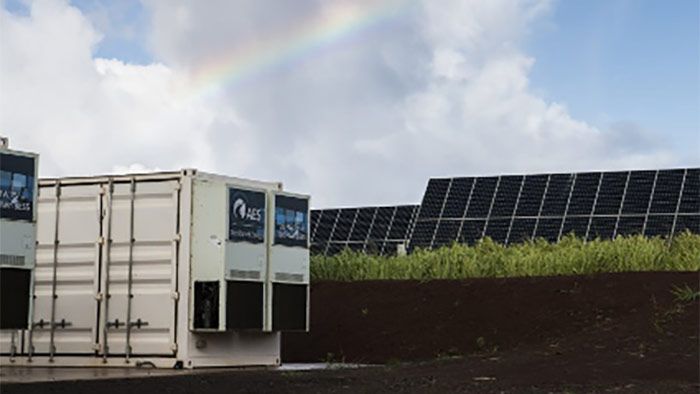
by Jon Harrod
Renewable energy is like local produce: abundant at times, scarce at others. This analogy has been at the front of my mind lately. Our family joined a Community Supported Agriculture (CSA) operation, and every Sunday, I drop by the farm to pick up our share of the harvest. This week’s box—the “small” share—contains lettuce, kale, cabbage, beets, potatoes, carrots, beans, and squash, all wonderfully fresh and clearly grown with love. There’s no way to eat them all before the next box arrives, and I can’t bear to see them go to waste. The answer, of course, is to store them. I’ve started blanching and freezing the greens and wax beans, knowing that next February, I’ll still be enjoying this summer’s bounty. If I wanted to live entirely on local produce, I’d need to re-learn the full suite of techniques—drying, canning, pickling, and root cellar storage—that my great grandparents employed a hundred years ago on their farm in Ohio.
Demand and the duck curve
Like local produce, the availability of wind and solar electricity varies over time. Photovoltaic (PV) modules only generate electricity when the sun is shining; wind turbines only produce when the wind blows. These resources fluctuate over the course of a day, day to day, and season to season. This variability presents a challenge to electric utilities, which are tasked with making sure power is always available when consumers need it. To do this, they need to match power supply continuously to changing demand. Historically, this has been done through a combination of baseload power plants and “peakers.” Baseload plants—natural gas, coal, nuclear, and hydro—provide a steady supply of power. Peaker plants—typically fed with natural gas—can be dispatched as needed during periods of peak demand. Incorporating variable renewable energy sources, which are neither steady, round-the-clock baseload plants nor dispatchable at will like peakers, presents a challenge.
This challenge is often illustrated using the “duck curve.” This phenomenon was first observed in California but can arise in any grid region. Before the rapid growth of PV, daily electric demand followed a simple pattern. It was low at night and ramped up gradually in the morning as people awoke and went to work. It remained steady throughout the workday, then ramped up again as people returned home and turned on lights, appliances, and air conditioning. After peaking in the evening, demand returned to low levels overnight.
PV panels reach maximum production in the middle of the day. While the electricity they produce reduces the need for generation from fossil fuels, it can’t be dispatched as needed by utilities. Rather than being counted as generation, it’s typically treated as a reduction in demand. The growth of PV depresses the “net demand”—the amount of power needed from other sources. The midday portion of the demand curve, once a plateau, develops a marked trough. The resulting shape has been compared to a duck, with the morning peak representing its hindquarters, the midday dip its back, and the evening ramp and peak its neck and head.
The more PV is installed on the grid, the more sway-backed the duck becomes. This creates multiple problems for utilities. Generation needs to be brought online more rapidly during the evening ramp. In addition, the difference between the minimum demand (now occurring midday, rather than at night) and the evening peak is increased. As a result, less baseload and more peaking capacity are needed. Peaker plants are particularly expensive to run; not only are they less efficient than baseload plants, but their lower hours of operation mean that they need to charge more per kWh to recoup their capital costs. If power plants can’t ramp down quickly enough to compensate for daytime increases in PV production, PV facilities may need to be “curtailed”—temporarily taken offline—costing revenue and losing the benefit of their carbon-free electricity.
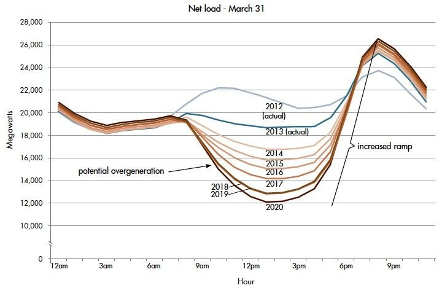
Energy storage technologies
Storage has emerged as a solution to the problems presented by the duck curve. During the day, when the sun is shining, a portion of the energy generated by PV panels is stored in batteries. This energy is released back to the grid in the evening. The result is to flatten the duck curve, reducing the midday trough and offsetting the need for peaker plants later in the day. Excess PV production can be stored rather than wasted.
The majority of new storage installations—in California and elsewhere—have been lithium-ion (Li-ion) batteries. According to a recent report by the U.S. Energy Information Administration, deployment of Li-ion batteries increased more than threefold from 1438 MW in 2020 to 4631 MW in 2021. This rapid growth has been driven in part by cost reductions; the cost per kWh has dropped by more than 80% since 2010. It also reflects the complementary relationship between PV and Li-ion batteries. Banks of Li-ion batteries can be located at solar farms, storing electricity when the sun is shining and electricity prices are low and selling it in the evening when it can command a higher price.
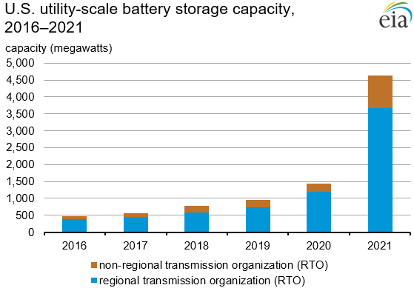
While most new grid-scale storage is Li-ion batteries, most existing storage capacity is based on an older technology. Pumped hydro facilities store and release electricity using a pair of reservoirs at different elevations. When electricity is abundant, water is pumped from the lower to the higher reservoir. When power is needed, the water flows to the lower reservoir, spinning a turbine to generate electricity.
There are currently 43 pumped hydro facilities representing 22 GW of capacity in the U.S. As of 2021, they represented 93% of our electric storage capacity. Many were built in the 1970s and paired with coal or nuclear plants. These plants—quintessential baseload—are most economical when they run at a steady output. Pumped hydro complements these plants, storing excess energy at night and releasing it during peak hours. While most projections show little or no growth in pumped-hydro storage, many potentially suitable sites are still available, both in the U.S. and elsewhere. It’s a robust and proven technology and, as the recent commissioning of a new pumped hydro facility in the Swiss Alps suggests, still has a role to play.
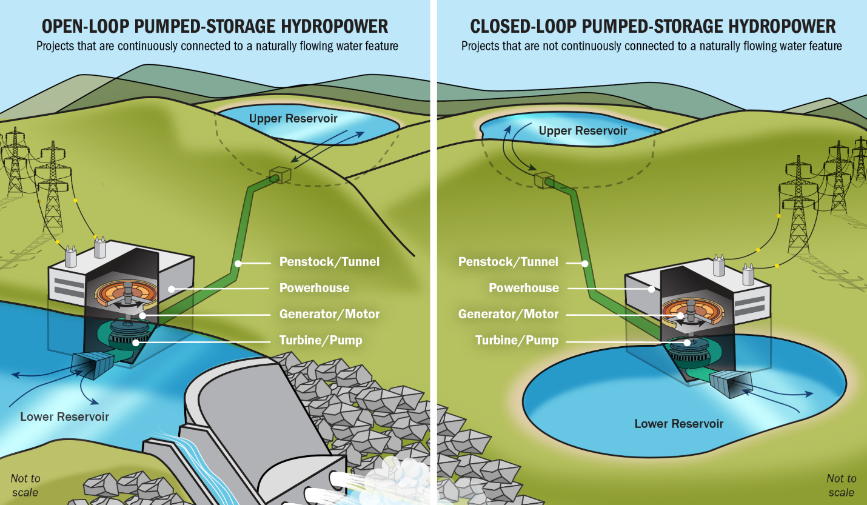
A recent series of DOE reports projects the growth of total grid-scale storage in the U.S. through 2050. In their reference scenario, based on current trends in storage, renewable energy, and fossil fuel costs, storage will increase from its current level of ~28 GW to more than 200 GW.
While Li-ion battery technology is expected to dominate, at least for the next decade, several new storage technologies are under development. A partial list includes:
- Flow batteries are in the early stages of commercialization. In a typical flow battery, the liquid electrolyte materials are kept in tanks separate from the active electrodes. This makes them inherently safer and less prone to fire than Li-ion batteries. Other potential advantages include longer lifespan and less reliance on exotic materials like lithium and cobalt.
- New gravity-based technologies allow gravitational storage in locations where pumped hydro is not feasible. One system, Energy Vault, uses an automated crane to raise and lower large concrete blocks. Another startup, Advanced Rail Energy Storage, stores and releases electricity by moving massive carts up and down an inclined rail line.
- Thermal storage converts sunlight or electricity to heat, which is later converted back to electricity. Large banks of mirrors concentrate sunlight on a container of molten salt. Later, when the sun goes down, the molten salt heats water which drives a steam turbine. One example is the recently-restarted Crescent Dunes concentrating solar plant in Nevada. Other technologies, still in development, seek to convert stored heat directly into electrical energy, much as a PV cell converts sunlight into electrical power.
- Compressed air systems store energy by compressing air in salt caverns and caves. The compressed air, which can reach pressures up to 1100 psi, is later used to spin turbines. Only a few grid-scale compressed air storage facilities are in operation worldwide, including a 110 MW plant in Alabama.
- Hydrogen can be produced by using electricity to split water molecules into their components. The hydrogen can later be recombined with oxygen to generate electricity, either through combustion or in a fuel cell.
Storage technologies will compete based on several metrics. Cost is key and is calculated both in terms of power ($/kW) and energy ($/kWh). Round-trip efficiency measures what percentage of the electricity originally captured can be returned to the grid. Li-ion batteries and pumped hydro feature round-trip efficiencies >80%; hydrogen is rated at around 35%. Growth of individual storage technologies may also be limited by raw materials (as in the case of Li-ion batteries) and suitable sites (e.g., compressed air and pumped hydro).
Benefits of energy storage
In making the economic case for storage technologies, it’s worth considering the multiple benefits storage brings to the grid. Much of the discussion, based largely on the challenges presented by the duck curve, has focused on time-shifting: absorbing excess renewable generation during the day and releasing it during the evening peak. I’ve seen this referred to in some places as “arbitrage”—buying low when supply is abundant and selling high when it’s scarce. Time-shifting can also help avoid curtailment during periods of excess PV production.
A related benefit is the ability of storage facilities to provide what utilities and regulators refer to as “firm capacity.” Utilities are required to have enough power available to meet projected peak demand. Many grid regulators allow storage facilities that can reliably deliver four hours’ worth of power to count toward that total, reducing the need for expensive peaker plants. Storage can also provide reserve capacity should an unexpected surge in demand occur or a power plant or transmission facility go offline.
Yet another benefit is frequency regulation. The U.S. electric grid needs to deliver AC power with a frequency very close to 60 Hz. But, just as increasing the load on a motor can cause it to slow down, an increase in demand can cause frequency to drop. Storage facilities can help maintain a constant frequency by rapidly absorbing or releasing power in response to changes in demand.
Discussion of storage capacity has often focused on the four-hour time frame since many grid regulators use this as a threshold for firm capacity. But a storage facility that can provide four hours of power at peak output can deliver it longer at partial output. Eventually, as the total amount of storage on the grid grows, longer duration storage—in the 10 to 12-hour range—will become commonplace, allowing renewables plus storage to meet daily energy needs for large parts of the year.
Changing the grid profile
To reach a 100% renewable grid, we will also need longer-term seasonal storage to meet demands during summer and winter peaks. In the Northeast, I’m particularly concerned with winter peaks since they often coincide with periods of minimal PV generation. Seasonal storage presents some extra challenges. The amount of energy stored needs to be large since it must be enough to carry the grid through a multi-day period of high demand. The economics are also tough. Shorter-term storage cycles nearly every day, generating value each time it releases energy. Seasonal storage, on the other hand, cycles only once or a few times per year.
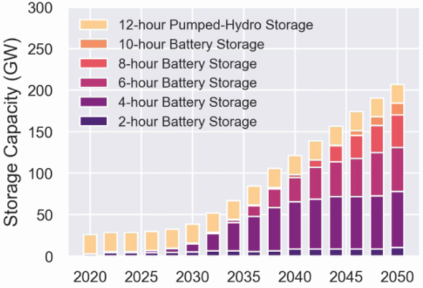
Renewably-generated (“green”) hydrogen is sometimes mentioned as an option for seasonal storage. For it to be effective in that role, its cost will need to come down, and its round-trip efficiency will need to go up. We’ll also need to scale up facilities to make, transport, and store it. Utilities may find themselves competing for green hydrogen with hard-to-electrify sectors like steel smelting and aviation. Other solutions for seasonal peaks may be possible; insulation, air-sealing, and high-efficiency heat pumps may reduce the need for heating and cooling, and improved transmission lines may make it possible to bring power poleward from warmer regions.
The good news is that, by the time we need to worry about seasonal storage, we’ll likely already have a grid that runs on 80+% renewables. I hope I’m still freezing vegetables in 2050 and that, by then, I’ll even have time to grow a few of my own. If so, there’s at least a chance I’ll be reheating them (on my induction cooktop, of course!) using electricity, like the kale, harvested the summer before.
_______________________________________________________________________
Originally published on GreenBuidingAdvisor.com. Jon Harrod is founder of Snug Planet, a contracting company in Ithaca, N.Y. Check out this episode of the Buildings + Beyond podcast to hear Jon talk about “The Role of Heat Pumps in Low- and Moderate-Income Homes.”





